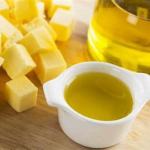
Introduction:
In the culinary world, oil is an indispensable ingredient, and its use extends far beyond mere greasing or frying. Indian cooking, in particular, embraces the versatility of oils, with ghee and olive oil being two prominent contenders. While both have their unique qualities, the age-old debate of which is better for Indian cooking persists. Ghee, known for its rich flavor and numerous benefits, finds its way into many Indian dishes. On the other hand, olive oil, celebrated for its health advantages, is often preferred in certain culinary scenarios. In this feature article, we delve deeper into the attributes of ghee and olive oil, examining their suitability for Indian cooking and highlighting the scenarios where each oil shines.
1. Ghee: The Time-Honoured Indian Gold
Ghee, a traditional clarified butter, has been an integral part of Indian cuisine for centuries. Its preparation involves heating butter until the milk solids separate and are removed, leaving behind a golden, pure fat. This process gives ghee its signature nutty flavor and a high smoke point, making it a remarkable choice for high-temperature cooking methods like frying, sautéing, and deep-frying. Its ability to withstand higher temperatures without breaking down and releasing harmful compounds makes it ideal for retaining the authentic flavors in Indian dishes.
Beyond flavor, ghee offers a myriad of health benefits. Rich in essential fatty acids, vitamins, and antioxidants, ghee supports heart health, aids digestion, boosts immunity, and even promotes healthy skin and hair. Its nutritional profile and distinctive taste have earned it a special place in Indian culinary culture.
2. Olive Oil: A Mediterranean Delicacy
Olive oil, a cornerstone of Mediterranean cuisine, has gained widespread popularity for its heart-friendly properties. Extracted from olives, this oil comes in various varieties, each with its unique flavor and nutritional profile. Extra virgin olive oil, obtained through cold pressing, retains the highest amount of antioxidants and healthy fats, making it the most sought-after variant.
One of the defining characteristics of olive oil is its low smoke point, which means it should not be used for high-temperature cooking. Heating olive oil to high temperatures can cause it to degrade and lose its healthful properties, leading to the formation of harmful compounds. However, its delicate taste and abundance of monounsaturated fats make it perfect for dressings, marinades, drizzling over roasted vegetables, and enhancing the flavours of salads.
3. Choosing the Right Oil for the Right Job
The choice between ghee and olive oil largely depends on the cooking method and desired flavor profile. When it comes to Indian cooking, particularly dishes that involve frying, sautéing, and tempering spices at higher temperatures, ghee reigns supreme. Its ability to elevate flavors and withstand heat ensures that the essence of Indian cuisine remains intact.
On the other hand, olive oil shines when it comes to lower-heat cooking or uncooked preparations like salads and dressings. Its fruity, earthy notes add a delightful dimension to salads and other dishes where it remains unheated.
4. A Harmonious Blend: The Best of Both Worlds
In some instances, a blend of ghee and olive oil can offer a balanced approach to Indian cooking. By mixing the two oils, one can attain a higher smoke point than olive oil alone, without overpowering the dish’s taste with ghee. This combination not only enhances the health benefits of the dish but also adds a unique and complex flavor profile.
Conclusion:
In the never-ending quest to find the perfect oil for Indian cooking, the debate between ghee and olive oil continues. Ghee’s higher smoke point and rich flavor make it an ideal choice for cooking Indian dishes at high temperatures. Meanwhile, olive oil’s healthful properties and delicate taste lend themselves well to salads and other uncooked preparations. Both oils have their place in the Indian kitchen, and with a mindful approach, one can harness the best of both worlds. Whether it’s the time-honored ghee or the Mediterranean delight of olive oil, let the nature of the dish guide the choice of oil and savor the delightful flavors of Indian cuisine.





